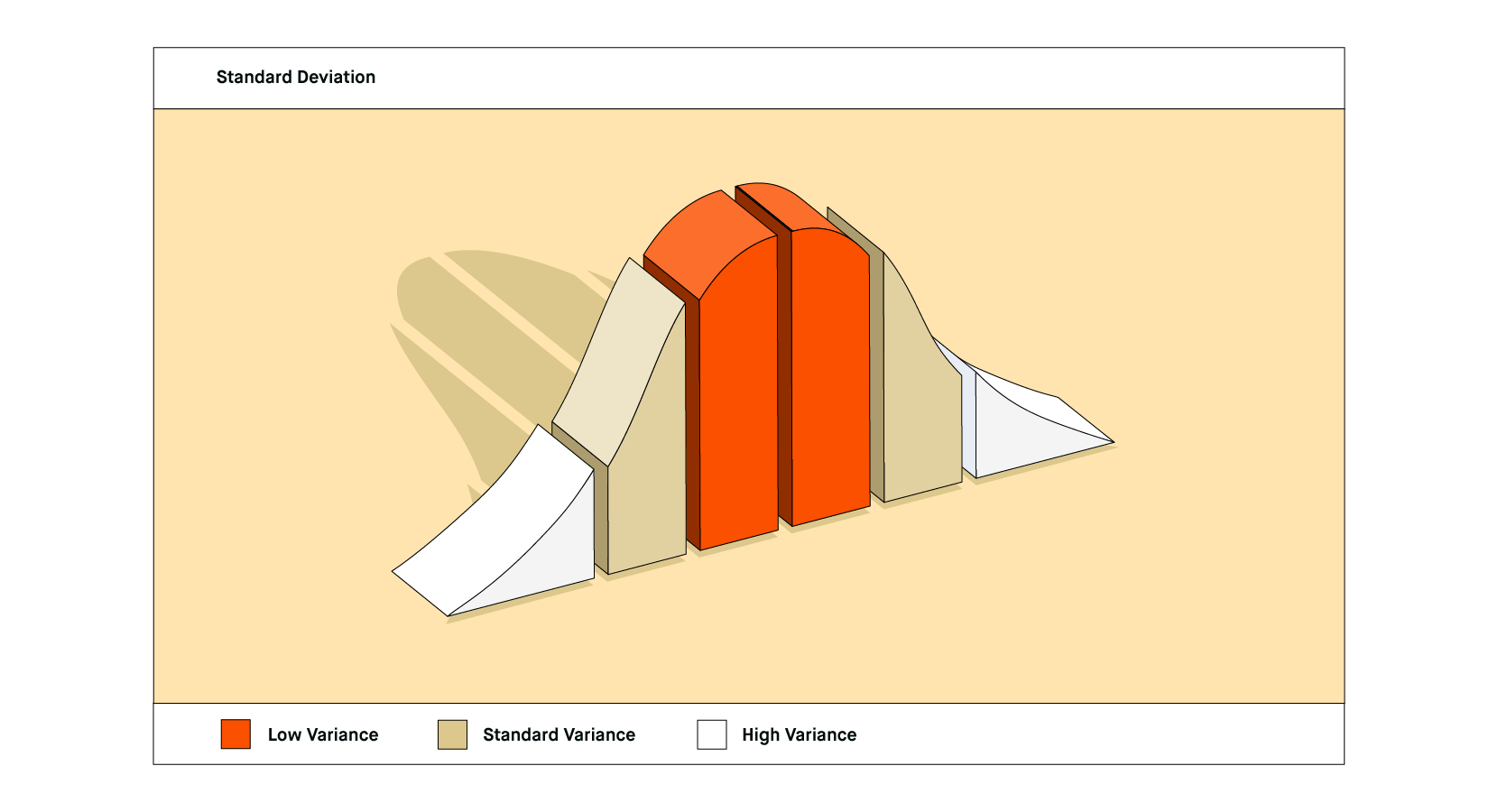What is Standard Deviation?
Standard deviation measures how much a stock’s price fluctuates from its average price, which sheds light on how risky the investment may be.
🤔 Understanding standard deviation
Standard deviation reveals how volatile a stock is. It looks at past prices to see how close or far they tend to be from the average price. Standard deviation is a numerical value that serves as the “standard” range within which a price will usually “deviate” from the average. A low standard deviation means prices are tightly clustered around the average line, and there is little fluctuation. A high standard deviation means prices are scattered further from the average line, and there is more variation. Standard deviation can be a good measure of risk, but there’s always a chance that investing in a stock may not pay off as expected. You can calculate standard deviation with a calculator or spreadsheet program.
Let’s say Sonia wants to invest in the most stable stock and must choose between two companies. She decides to calculate and compare the standard deviation of both stocks. She starts by looking at the past five closing prices, which is called a 5-period standard deviation. Sonia then calculates the standard deviation of Stock A and Stock B (all values are in dollars):
Sonia notices both stocks have the same average closing price of $10. However, Stock A has a standard deviation of $3.58, while Stock B has a standard deviation of $1.41. She concludes that Stock B’s price fluctuates less than Stock A’s and decides to invest in Stock B.
Takeaway
Standard deviation is like a measuring stick for risk…
It tells you how risky a stock may be judging by how all over the place prices have been in the past. The higher the standard deviation, the more cautious investors may want to be.
New customers need to sign up, get approved, and link their bank account. The cash value of the stock rewards may not be withdrawn for 30 days after the reward is claimed. Stock rewards not claimed within 60 days may expire. See full terms and conditions at rbnhd.co/freestock. Securities trading is offered through Robinhood Financial LLC. Futures trading offered through Robinhood Derivatives, LLC.
How do you calculate standard deviation?
The Greek letter sigma (σ) commonly represents standard deviation in equations. Here’s the formula:
Standard Deviation = ❘x-x❘2n
∑ = Sum of ❘❘ = The set of prices x = A price in the set X̄ = The average of the prices n = The number of prices
You can calculate standard deviation with a calculator or spreadsheet program.
With a calculator
First, select a period of past closing prices for a stock. For example, you could look at a 10-period standard deviation, which looks at the closing prices for the last ten trading days. Next:
1. Find the average closing price: Add the prices, and divide the value by the number of prices in the set.
2. Subtract the average from each price: It helps to use a table for this step (see the example above). Take each closing price and subtract the average, creating a list of differences.
3. Square each difference: This makes the numbers positive. It also puts more stress on returns further from the average.
4. Average the squares: Add the squared differences, and divide the value by the number of closing prices.
5. Square root the value: This puts the value back into the units of the data set. Congratulations! You calculated the standard deviation.
With a spreadsheet program
As you can imagine, it takes a long time to calculate standard deviation when you have a massive set of numbers. To make the math easier and faster, you can do the job with a spreadsheet program like Excel. Here’s how:
1. Manually type in the set of closing prices: Each price should have its own cell. Start in A1, and proceed down the column.
2. Select a cell to display the standard deviation: After you enter the prices, select a different cell that will eventually show the standard deviation value, such as C1.
3. Type “=” and select “STDEV,” “STDEV.S” or “STDEV.P”: Once you type “=STEV,” the program will provide a list of equations to choose from.
How to choose the right formula: “STDEV.P” calculates the standard deviation of an entire population of a data set. “STDEV” or “STDEV.S” (depending on which software you use) calculates the standard deviation for a sample of data to represent an entire population. For example, if you’re calculating the standard deviation for 1,000 closes, use the population formula. If you’re using 300 of those closes to generalize about the standard deviation of all 1,000, then use the sample formula.
4. Highlight your closing prices: Highlight A1 and downwards until you select all your prices. This tells the program which set it should calculate the standard deviation for.
5. Hit enter: The cell that will display the value should look something like this: =STDEV.P(A1: A100). The ending value “A100” will be different depending on how many returns you have. At this point, you can hit “enter,” and the cell will produce the standard deviation of the set you highlighted.
Is standard deviation a good measure of risk?
The short answer is yes, but it’s not perfect.
Standard deviation tells you how much a stock’s price fluctuated around its average price in the past. In turn, this gives you an idea of how risky it is. A lower standard deviation is less risky because the stock is going up and down only a little. A higher standard deviation is riskier because the stock price varies a lot.
However, a higher standard deviation is not necessarily undesirable. For example, investors with a higher risk tolerance may invest in stocks with a high standard deviation because they have a chance to receive high returns (although the risk of losses also increases). More conservative investors may go for stocks with a lower standard deviation because they want stability and to minimize loses.
How you use standard deviation will depend on your personality, financial goals, and tolerance for volatility.
The 68-95-99.7 rule
The 68-95-99.7 rule (also called the “empirical rule”) is a convenient shorthand to help people remember what percentage of closing prices fall within certain ranges:
- 68% fall within one standard deviation
- 95% fall within two standard deviations
- 99.7% fall within three standard deviations
- 0.3% of returns go beyond three standard deviations and are extreme values
For example, let’s say you’re looking at the last 1,000 closing prices of stock, and the standard deviation is $5. According to the 68-95-99.7 rule, out of those 1,000 closes:
- 680 closes will be within $5 of the average
- 950 closes will be within $10 of the average
- 997 closes will be within $15 of the average
- 3 closes will go beyond $15 from the average
Of course, calculating and interpreting standard deviation does not guarantee you can accurately predict how much a stock’s price will increase or decrease.
How to interpret a bell curve
A set of closing prices is a normal distribution of data, which means the values are roughly symmetrical, with the average line in the middle. That means standard deviation can appear visually as a bell curve. The bell curve shows you the number of closing prices surrounding the average. It’s a visual way to see if a stock has a low or high standard deviation.
A tall and thin bell curve means closing prices are closer to the average, representing a lower standard deviation. A short and wide bell curve means closing prices are further from the average, representing a higher standard deviation.
What are the drawbacks of standard deviation?
There are three main limitations to using standard deviation to assess how volatile a stock is:
- Standard deviation is based on historical data, which means it does not guarantee future performance. A variety of factors can cause an average to change, which would throw off any predictions.
- Even if standard deviation accurately predicts future stock prices, there is still a chance a stock could reach an extreme value. These are outliers, which are the prices that go beyond a number of standard deviations. This can happen when the stock suddenly plummets or skyrockets (for example, in response to an event like the market crash of 2008).
- Standard deviation doesn’t tell you if the price of a stock is increasing or decreasing. It tells you how much returns fluctuate from the average, not whether future prices will be below or above the average.
Standard deviation is not a stand-alone statistic. You may want to use it with other data to inform your financial decisions.
What is the difference between standard deviation and variance?
Variance is another way to measure volatility. Standard deviation displays the value of fluctuation in the same units as the stock, while variance displays the value in units squared. For example, if you’re looking at a stock in dollars, then its standard deviation will also be in dollars, but its variance will be in dollars squared. In other words, the square root of the variance is the standard deviation.
New customers need to sign up, get approved, and link their bank account. The cash value of the stock rewards may not be withdrawn for 30 days after the reward is claimed. Stock rewards not claimed within 60 days may expire. See full terms and conditions at rbnhd.co/freestock. Securities trading is offered through Robinhood Financial LLC. Futures trading offered through Robinhood Derivatives, LLC.

